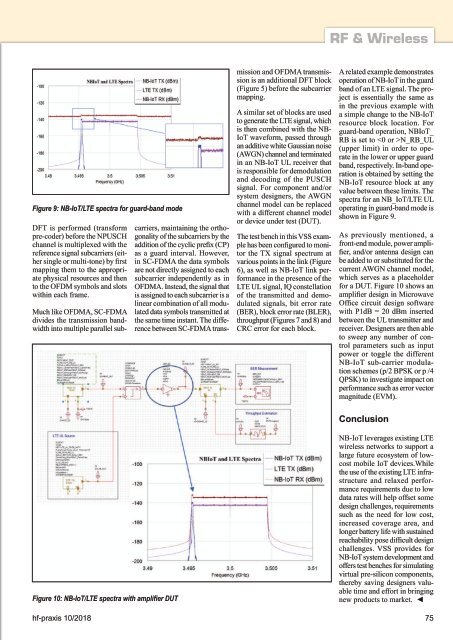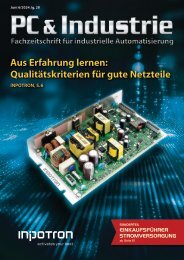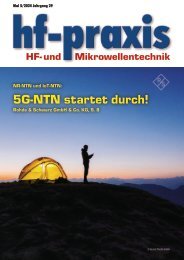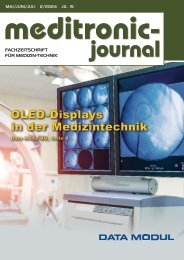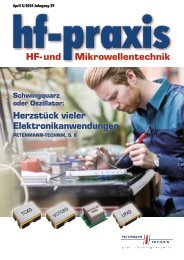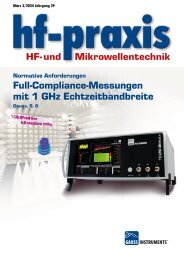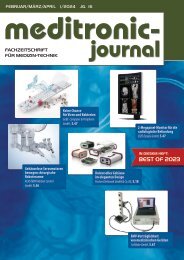10-2018
Fachzeitschrift für Hochfrequenz- und Mikrowellentechnik
Fachzeitschrift für Hochfrequenz- und Mikrowellentechnik
Erfolgreiche ePaper selbst erstellen
Machen Sie aus Ihren PDF Publikationen ein blätterbares Flipbook mit unserer einzigartigen Google optimierten e-Paper Software.
RF & Wireless<br />
Figure 9: NB-IoT/LTE spectra for guard-band mode<br />
DFT is performed (transform<br />
pre-coder) before the NPUSCH<br />
channel is multiplexed with the<br />
reference signal subcarriers (either<br />
single or multi-tone) by first<br />
mapping them to the appropriate<br />
physical resources and then<br />
to the OFDM symbols and slots<br />
within each frame.<br />
Much like OFDMA, SC-FDMA<br />
divides the transmission bandwidth<br />
into multiple parallel sub-<br />
carriers, maintaining the orthogonality<br />
of the subcarriers by the<br />
addition of the cyclic prefix (CP)<br />
as a guard interval. However,<br />
in SC-FDMA the data symbols<br />
are not directly assigned to each<br />
subcarrier independently as in<br />
OFDMA. Instead, the signal that<br />
is assigned to each subcarrier is a<br />
linear combination of all modulated<br />
data symbols transmitted at<br />
the same time instant. The difference<br />
between SC-FDMA transmission<br />
and OFDMA transmission<br />
is an additional DFT block<br />
(Figure 5) before the subcarrier<br />
mapping.<br />
A similar set of blocks are used<br />
to generate the LTE signal, which<br />
is then combined with the NB-<br />
IoT waveform, passed through<br />
an additive white Gaussian noise<br />
(AWGN) channel and terminated<br />
in an NB-IoT UL receiver that<br />
is responsible for demodulation<br />
and decoding of the PUSCH<br />
signal. For component and/or<br />
system designers, the AWGN<br />
channel model can be replaced<br />
with a different channel model<br />
or device under test (DUT).<br />
The test bench in this VSS example<br />
has been configured to monitor<br />
the TX signal spectrum at<br />
various points in the link (Figure<br />
6), as well as NB-IoT link performance<br />
in the presence of the<br />
LTE UL signal, IQ constellation<br />
of the transmitted and demodulated<br />
signals, bit error rate<br />
(BER), block error rate (BLER),<br />
throughput (Figures 7 and 8) and<br />
CRC error for each block.<br />
A related example demonstrates<br />
operation of NB-IoT in the guard<br />
band of an LTE signal. The project<br />
is essentially the same as<br />
in the previous example with<br />
a simple change to the NB-IoT<br />
resource block location. For<br />
guard-band operation, NBIoT_<br />
RB is set to N_RB_UL<br />
(upper limit) in order to operate<br />
in the lower or upper guard<br />
band, respectively. In-band operation<br />
is obtained by setting the<br />
NB-IoT resource block at any<br />
value between these limits. The<br />
spectra for an NB_IoT/LTE UL<br />
operating in guard-band mode is<br />
shown in Figure 9.<br />
As previously mentioned, a<br />
front-end module, power amplifier,<br />
and/or antenna design can<br />
be added to or substituted for the<br />
current AWGN channel model,<br />
which serves as a placeholder<br />
for a DUT. Figure <strong>10</strong> shows an<br />
amplifier design in Microwave<br />
Office circuit design software<br />
with P1dB = 20 dBm inserted<br />
between the UL transmitter and<br />
receiver. Designers are then able<br />
to sweep any number of control<br />
parameters such as input<br />
power or toggle the different<br />
NB-IoT sub-carrier modulation<br />
schemes (p/2 BPSK or p /4<br />
QPSK) to investigate impact on<br />
performance such as error vector<br />
magnitude (EVM).<br />
Figure <strong>10</strong>: NB-IoT/LTE spectra with amplifier DUT<br />
Conclusion<br />
NB-IoT leverages existing LTE<br />
wireless networks to support a<br />
large future ecosystem of lowcost<br />
mobile IoT devices.While<br />
the use of the existing LTE infrastructure<br />
and relaxed performance<br />
requirements due to low<br />
data rates will help offset some<br />
design challenges, requirements<br />
such as the need for low cost,<br />
increased coverage area, and<br />
longer battery life with sustained<br />
reachability pose difficult design<br />
challenges. VSS provides for<br />
NB-IoT system development and<br />
offers test benches for simulating<br />
virtual pre-silicon components,<br />
thereby saving designers valuable<br />
time and effort in bringing<br />
new products to market. ◄<br />
hf-praxis <strong>10</strong>/<strong>2018</strong> 75


